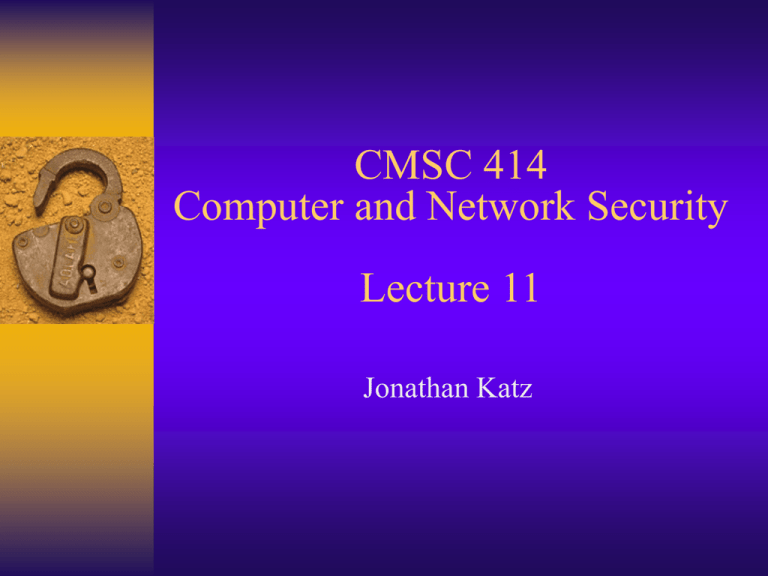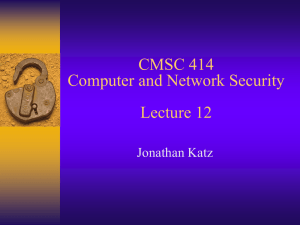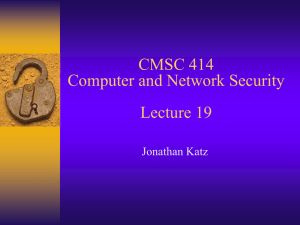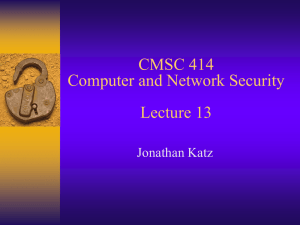CMSC 414 Computer and Network Security Lecture 11 Jonathan Katz
advertisement

CMSC 414 Computer and Network Security Lecture 11 Jonathan Katz Announcements Midterm – Closed book, closed notes – Covers material through today’s lecture – Everything linked from the course syllabus HW2 out “Capability myths…” Equivalence myth: ACLs and capabilities are “just” two views of the AC matrix Confinement myth: Capability systems cannot enforce confinement – That is, cannot restrict delegation Irrevocability myth: Capabilities cannot be revoked Equivalence myth ACLs have “arrows” from objects to subjects; capabilities have “arrows” from subjects to objects Capabilities do not require subjects to “know” object names a priori Capabilities do not require subjects to “know” whether they have authority – They have authority by virtue of the fact that they have a capability! – In contrast, with ACLs how do I obtain a list of all files I am allowed to read? Equivalence myth Capabilities allow for finer-grained treatment of subjects – Processes rather than user accounts ACLs potentially require objects to be aware of all subjects Capabilities allow greater flexibility to delegate permissions – In ACLs, usually all-or-nothing – In capability-based systems, can delegate a subset of the rights you have Confinement myth Myth: Capabilities can be delegated “at will” and therefore cannot be confined But…can be set up so that A can delegate a capability to B only if A is authorized to pass capabilities to B – If B is untrusted, then the latter capability will not exist Origin of confinement myth Mistaken assumption that the ability to write/read files translates into the ability to read/write capabilities – Capabilities should not be viewed as “just” files; they can be typed by the OS Revocation One solution: indirection – Capabilities name an entry in a table, rather than the object itself – To revoke access to object, invalidate or change the entry in the table – Difficult to revoke access of a single user Capabilities can also expire with time If OS stores capabilities, can delete upon request – Requires object to recall to whom capabilities given Advantages of capabilities Better at enforcing “principle of least privilege” – Provide access to minimal resources, to the minimal set of subjects – We have seen already that capabilities allow much finer-grained control over subjects (process-level instead of user-level) Advantages… Avoiding “confused deputy” problem – “Deputy” = program managing authorities from multiple sources – In the example we have seen, the problem was not the compiler having the wrong authority, but of exercising its authority for the wrong purpose Confused deputy… Capabilities give the ability to identify the authority a subject is using – Can designate use of the authority for a specific purpose Capabilities also tie together designation and authority – Don’t “know” about a resource if you don’t have the capability to access it! – Any request to access a resource must include the necessary authority to do so --- “deputy” can now examine the context of the request Disadvantages of capabilities Overhead Revocation more difficult Controlling delegation more difficult Making files world-readable more difficult (impossible?) Mandatory access control “Military security policy” Primarily concerned with secrecy Objects given “classification” (rank; compartments) Subjects given “clearance” (rank; compartments) “Need to know” basis – Subject with clearance (r, C) dominates object with classification (r’, C’) only if r r’ and C’ C – Defines a lattice … classifications/clearance not necessarily hierarchical Security models Bell-LaPadula model – Identifies allowable communication flows – Concerned primarily with ensuring secrecy Biba model – Concerned primarily with “trustworthiness”/integrity of data Chinese wall – Developed for commercial applications Bell-LaPadula model Simple security condition: S can read O if and only if lo ls *-property: S can write O if and only if ls lo – Why? “Read down; write up” – Information flows upward Dynamic rights Could consider dynamic rights – Once a process reads a file at one security level, cannot write to any file at a lower security level Basic security theorem If a system begins in a secure state, and always preserves the simple security condition and the *-property, then the system will always remain in a secure state – I.e., information never flows down… Communicating down… How to communicate from a higher security level to a lower one? – Max. security level vs. current security level – Maximum security level must always dominate the current security level – Reduce security level to write down… • Security theorem no longer holds • Must rely on users to be security-conscious Commercial vs. military systems The Bell-LaPadula model does not work well for commercial systems – Users given access to data as needed • Discretionary access control vs. mandatory access control – Would require large number of categories and classifications – Centralized handling of “security clearances” Biba model Concerned with integrity – “Dual” of Bell-LaPadula model The higher the level, the more confidence – More confidence that a program will act correctly – More confidence that a subject will act appropriately – More confidence that data is trustworthy Integrity levels may be independent of security classifications – Confidentiality vs. trustworthiness – Information flow vs. information modification Biba model Simple integrity condition: S can read O if and only if Is Io – Is, Io denote the integrity levels (Integrity) *-property: S can write O if and only if Io Is – Why? – The information obtained from a subject cannot be more trustworthy than the subject itself “Read up; write down” – Information flows downward Security theorem An information transfer path is a sequence of objects o1, …, on and subjects s1, …, sn-1, such that, for all i, si can read oi and write to oi+1 – Information can be transferred from o1 to on via a sequence of read-write operations Theorem: If there is an information transfer path from o1 to on, then I(on) I(o1) – Informally: information transfer does not increase the trustworthiness of the data Note: says nothing about secrecy… “Low-water-mark” policy Variation of “pure” Biba model If s reads o, then the integrity level of s is changed to min(Io, Is) – The subject may be relying on data less trustworthy than itself – So, its integrity level is lowered Drawback: the integrity level of a subject is non- increasing! Chinese wall Intended to prevent conflicts of interest Rights are dynamically updated based on actions of the subjects Chinese wall -- basic setup Company datasets Bank A Bank B School 1 School 2 School 3 Conflict of interest (CI) class files Chinese wall rules Subject S is allowed to read from at most one company dataset in any CI class – This rule is dynamically updated as accesses occur – See next slide… Example Bank A Bank B School 1 School 2 School 3 read read Chinese wall rules II S can write to O only if – S can read O and – All objects that S can read are in the same dataset as O This is intended to prevent an indirect flow of information that would cause a conflict of interest – E.g., S reads from Bank A and writes to School 1; S’ can read from School 1 and Bank B – S’ may find out information about Banks A and B! Note that S can write to at most one dataset…









